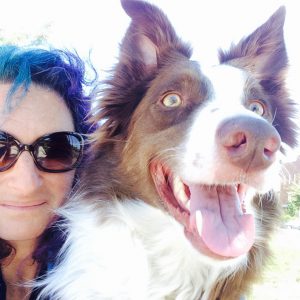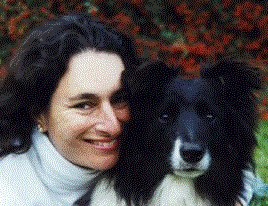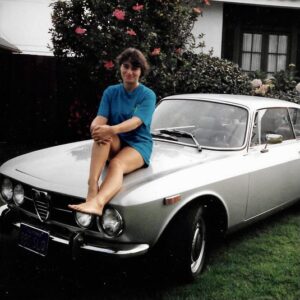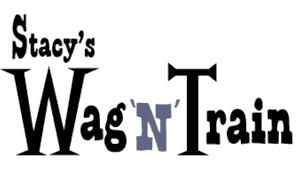Behavior Specialist, Instructor and Owner
Celebrating over 25 years as Silicon Valley’s expert dog trainer and behavior specialist!
 Stacy Braslau-Schneck is dedicated to helping pet dog owners solve their behavior problems and “love their well-trained dogs” through her unique combination of experience, education, knowledge, and skills!
Stacy Braslau-Schneck is dedicated to helping pet dog owners solve their behavior problems and “love their well-trained dogs” through her unique combination of experience, education, knowledge, and skills!
Stacy pursued her lifelong interest in animal behavior through a Master’s degree (MA) at a research laboratory, Kewalo Basin Marine Mammal Lab (KBMML, now called The Dolphin Institute) in Hawaii, studying dolphin cognition and intelligence. At the lab, she learned to train dolphins for research and exercise, using the same modern techniques that are now used with pet dogs. She designed and ran a research project investigating how creative dolphins could be and how they coordinate their movements with each other. As a staff member at the lab, one of her duties was to teach dolphin training to new volunteers and students.
When she returned to her native California she began transferring her animal-training and student-teaching skills to teaching pet owners how to train their dogs. She was asked to help develop and teach the first clicker training classes at the San Francisco SPCA, before moving to San Jose.
She has been a professional member of the Association of Professional Dog Trainers (APDT), an organization that encourages the exchange of ideas and continuing education of pet dog trainers. In 2001, she was awarded Member of the Year, and in 2002 she earned a Level 1 Certified Professional Dog Trainer-Knowledge Assessed (CPDT-KA) and Certified Behavior Consultant Canine-Knowledge Assessed (CBCC-KA), the advanced certification for dog trainers who offer canine behavior modification, through the Certification Council for Professional Dog Trainers (CCPDT), the first national certification for dog trainers in history. Both of these certifications require continuing education to maintain them; this means that a person certified through these programs is continually learning about the latest developments and understandings, and not just repeating “old wives’ tales” and the same unrefined training methods year after year. Over the years she has attended the Marin Humane Society Dog Trainers Academy and Dogs Of Course’s Advanced Instructor Training Course. She has been continuing her education ever since, including completing Susan Friedman’s LLA Course, attending several Canine Science Symposium events, involved in monthly Research Bites webinars from Science Matters, and attending multiple conferences with the Association of Professional Dog Trainers and ClickerExpo. More recently she’s attended the Convergence of Human & Animal Training and Technology (CHATT), The Lemonade Conference, a few Fenzi Dog Sports Academy classes, the Aggression In Dogs Conference, the Adolescent Dog Conference, the Karen Pryor Academy Dive Deep Advanced Animal Training Course and the Modern & Ethical Training Conference.
 In January 2005, Stacy achieved Kay Lawrence’s “Competency Assessment Programme” (CAP) test at the second level “with distinction”. CAP tests the trainer, not the dog. The trainer must demonstrate her decision-making prowess, and her ability to communicate with the dog, use a target, shape, fade lures and targets, use hand signals or verbal commands, capture and shape new behaviors. Stacy was among the first in the USA to attain CAP certification. In 2006 Stacy was asked to become a member of the Board of Directors as well as a presenter for KADIE (Kids and Dogs Interactive Education), to help develop and promote an educational program to reduce dog bites to children. In 2015 she was recruited by DogBiz to teach the Dog Walking Academy in Silicon Valley.
In January 2005, Stacy achieved Kay Lawrence’s “Competency Assessment Programme” (CAP) test at the second level “with distinction”. CAP tests the trainer, not the dog. The trainer must demonstrate her decision-making prowess, and her ability to communicate with the dog, use a target, shape, fade lures and targets, use hand signals or verbal commands, capture and shape new behaviors. Stacy was among the first in the USA to attain CAP certification. In 2006 Stacy was asked to become a member of the Board of Directors as well as a presenter for KADIE (Kids and Dogs Interactive Education), to help develop and promote an educational program to reduce dog bites to children. In 2015 she was recruited by DogBiz to teach the Dog Walking Academy in Silicon Valley.
Stacy’s writing on dog training and animal behavior has appeared in several publications, from the Association of Pet Dog Trainer’s Chronicle of the Dog and The Clicker Journal, to local club newsletters like the Prairielands Bloodhound Club “Puppy Issue”, the Arizona Pointing Dog Club, and the Los Vast, Nederlandse Vereniging voor Insturcteurs in Honden (the Dutch Dog Training Club). She was a paid writer for Exceptional Canine. References to her writing are found in several books, including Peggy Tillman’s Clicking With Your Dog, and she has a chapter in The Dog Trainer’s Resource published in 2006. Most recently she has published training articles in Bay Woof on training “come”, stopping jumping, barking at skateboards, and more. She is an instructor for several Telecourses (telephone conference-call seminars) for Raising Canine, an international resource for dog-training and teaching seminars. Even though Wag’N’Train is a one-person operation, Stacy won “best Private Trainer” in the South Bay in Bay Woof’s “Beast of the Bay” competition, and first place “Trainer of the Year” through SniffSpot. She is currently working on Office Buddies, a book about having dogs in the workplace.
Stacy has worked closely with the Humane Society Silicon Valley, socializing dogs awaiting adoption, teaching staff and volunteer socializers, and fostering puppies and “issue-challenged” dogs. She has lived with Shelties, a herding-dog mix, and an “All-American” (mutt), as well as rats, hamsters, and numerous fish, and of course she worked with four great bottlenosed dolphins. She shared 14 wonderful years with Flipper, a black-and-white Border Collie mix adopted from the Humane Society in September 1999, and currently lives with Fletcher, a red Border Collie adopted at a year of age, from Marin Humane Society, with a “laundry list of behavior problems”, including dog aggression, resource guarding, handling issues, counter-surfing, and more. Fletcher has overcome enough of his issues that they are training in Nose Work (earning his ORT and NW1 so far) and Agility, and he shares his yard with the family’s six chickens. Stacy lives with with her husband and had a daughter in 2003, giving her a better understanding of the issues faced by families with young children!
Stacy is dedicated to using methods that are humane and effective. She subscribes to the “LIMA” training philosophy, which means she has a commitment to use the “Least Invasive, Minimally Aversive” methods* and techniques that will be effective for each client, knowing which methods to avoid due to the likelihood of unwanted fallout. All dogs and their situations are different, but all dogs follow the laws of learning, and Stacy is dedicated to using positive reinforcement techniques. Stacy says, “You can do anything to me that I might suggest doing to your dog – except feed me liver treats”!

“Stacy has a gift for teaching and for communicating with other species”
— from a class evaluation (anonymous)
Contact Stacy at stacy@wagntrain.com.


I live on, work on, and respect the Tamien Ohlone lands. I pay a voluntary land tax through tamien.org and you can, too!

* (LIMA has gotten some weird interpretations lately, so to clarify, I follow Dr. Susan Friedman’s interpretation. I look at general background questions of wellness and immediate antecedent arrangements, then plan to apply positive reinforcement and DRA [differential reinforcement of alternative behaviors] and to allow extinction [unwanted behaviors fail to result in rewards]. If it’s possible to take advantage of negative reinforcement [removing aversive stimuli as a consequence of behavior] or negative punishment [removing desired stimuli as a consequence of behavior] without unduly stressing the dog, I will do that. I will NOT incorporate positive punishment [applying or allowing aversive stimuli as a consequence of behavior] as any part of any training plan. For more information on the jargon of positive/negative reinforcement/punishment, see my page An Animal Trainer’s Introduction To Operant and Classical Conditioning).
The 3 Questions
Jean Donaldson proposes three questions that all pet owners should ask to prospective dog trainers:
-
- What will happen to my dog if he gets it right?
When your dog gets the behavior right, I will do my best to provide a reward that your dog considers valuable, in proportion to the difficulty of the task, in a timely manner.
-
- What will happen to my dog if he gets it wrong?
When your dog gets the behavior wrong, I will withhold reinforcement, and evaluate the situation to see what can be changed to make it easier for us to achieve success. Does the dog understand the behavior that is desired? Does the dog understand what the favorable consequence will be? Did the dog perceive the cue? Is the dog feeling safe enough to perform the behavior? While I might interrupt unwanted behavior, or act quickly to remove the dog from a situation, I will never intentionally use force, intimidation, punishment, scare-tactics, “alpha” displays, or any devices designed to startle, hurt, “tickle”, “tap”, or “stimulate” your dog to stop a behavior.
-
- Are there any less invasive alternatives to what you propose?
If there are, I will do my best to find them! I keep myself updated on modern, humane, positive training technique to ensure that I am helping you and your dog with compassion and skill!


